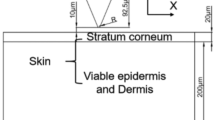Abstract
A CNT-based electrode was developed for flexible electrocardiogram (ECG) electrodes with a mixture of polydimethylsiloxane (PDMS) and carbon nanotubes (CNT). In this study, the electrical characteristics of the electrode were evaluated as to the CNT concentration, CNT dispersion and fabrication condition. To obtain good electrical performance of film, the good dispersion of CNT and PDMS is one of great challenges, and we employed the modified two-step method for this purpose. The electrical property of the film by the two step method was much more enhanced than that by the conventional one step method. The electrical properties of the film depended on the film thickness which was controllable by spin coating speed and the flow property of the fluid. Based on these experiments, we found that ECG electrodes require less than 1.5wt% CNT for the desired performance. The 1.5wt% CNT/PDMS film showed optimal mechanical and electrical performance which enabled it to be used as an ECG electrode. We measured the ECG signals from the human skin, and the signal quality was comparable to commercial ECG electrodes.
Similar content being viewed by others
References
Webster, J.G., Clark, J.W., in: J.G. Webster (Ed.) Medical Instrumentation, Wiley, New York (1998).
Ruffini, G. et al. A dry electrophysiology electrode using CNT arrays, Sens. Actuat. A 132, 34–41 (2006).
Lim, Y.G. et al. Monitoring physiological signals using nonintrusive sensors installed in daily life equipment, Biomed. Eng. Lett. 1, 11–20 (2011).
Baek, J.-Y., An, J.-H., Choi, J.-M., Park, K.-S. & Lee, S.-H. Flexible polymeric dry electrodes for the long term monitoring of ECG, Sens. Actuat. A 143, 423–429 (2008).
McAdams, E.T., Jossinet, J., Lackermeier, A. & Risacher, F. Factors affecting electrode-gel-skin interface impedance in electrical impedance tomography, Med. Biol. Eng. Comput. 34, 397–408 (1996).
Oehler, M., Schilling, M., Ling, V. & Melhorn, K., A multichannel portable ECG system with capacitive sensors, Physiol. Meas. 29, 783–793 (2008).
Kim, M.S., Cho, Y.C., Seo, S.-T., Son, C.-S. & Kim, Y.-N. A new method of ECG feature detection based on combined wavelet transform for u-health service, Biomed. Eng. Lett. 1, 108–115 (2011).
Yoon, U.-j., Noh, Y.-S. & Yoon, H.-r. Optimization methods for improving the performance of heart rate detection by a wearable ECG system during high-intensity exercise, Biomed. Eng. Lett. 1, 143–150 (2011).
Huang, Y.-Y. & Chou, K.-S. Studies on the spin coating process of silica films, Ceramics International 29, 485–493 (2003).
Harris, Peter J.F. (1999) Carbon nanotubes and related structures: new materials for the 21st century, Cambridge University Press.
Prashantha, K. et al. Multi-walled carbon nanotube filled polypropylene nanocomposites based on masterbatch route, eXPRESS Polymer Lett. 2, 735–745 (2008).
Bauhofer, W. & Kovacs, J.Z. A review and analysis of electrical percolation in carbon nanotube polymer composites, Comp. Sci. Technol. 69, 1486–1498 (2009).
Hong, J.S., Hong, I.G., Lim, H.T., Ahn, K.H., & Lee, S.J. In situ lubrication dispersion of multi-walled carbon nanotubes in polypropylene melt, Macro. Mat. Eng. online published (DOI:10.1002/mame.201100192) (2011).
Abbasi, S. et al. Rheological properties and percolation in suspensions of multiwalled carbon nanotube in polycarbonate. Rheol. Acta 48, 943–959 (2009).
Jung, H.-C. et al. CNT/PDMS composite flexible dry electrode for long-term ECG monitoring, accepted for publication in IEEE T Bio-Med Eng.
Hobbie, E.K. & Fry, D.J. Nonequilibrium phase diagram of sticky nanotube suspensions. Phys. Rev. Lett. 97, 036101 (2006).
Ma, A.W.K., Mackley, M.R. & Rahatekar, S.S. Experimental observation on the flow-induced assembly of carbon nanotube suspensions to form helical bands. Rheol. Acta 46, 979–987 (2007).
Montesi, A., Pena, A.A. & Pasquali, M. Volticity alignment and negative normal stresses in sheared attractive emulsions. Phys. Rev. Lett. 92, 058303 (2004).
Emslie, A.G., Bonner, F.T. & Peck, L.G. Flow of a viscous liquid on a rotating disk, J. App. Phy. 29, 858–862 (1958).
Author information
Authors and Affiliations
Corresponding author
Rights and permissions
About this article
Cite this article
Lee, J.H., Nam, Y.W., Jung, HC. et al. Shear induced CNT/PDMS conducting thin film for electrode cardiogram (ECG) electrode. BioChip J 6, 91–98 (2012). https://doi.org/10.1007/s13206-012-6112-9
Received:
Accepted:
Published:
Issue Date:
DOI: https://doi.org/10.1007/s13206-012-6112-9




